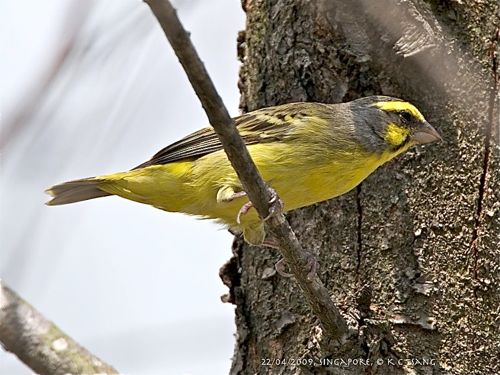KC Tsang came across another exotic escape, a very rare illegal immigrant to our shores at Ponggol Grassland. It puzzled him as to its identity as it is not in his Robson field guide. He had to resort to his international e-forum to help in its identification.
The pair he encountered is the Yellow-fronted Canary (Serinus mozambicus), a common bird found in open woodlands, savanna, and gardens in Sub-saharan Africa.
“Well, looks like it will establish itself well here if they are to start breeding, as Ponggol Grassland looks, in a way, like the Sub-saharan region of Africa.”
Summerian Turks adds his piece: “Its not uncommon to see this species here. They are imported by the thousands annually to supply the song bird market. They are often imported from Mozambique, Guinea, Senegal, etc. It was listed as non-CITES by Ghana in 2007. The rest list the species as CITES Appendix III. This year alone, Senegal issues an export quota of 100,000 wild caught birds. Captive breeding can never meet this demand.
“The imported birds cater for both local and international markets. In 2006 alone, more than 7,000 birds were re-exported to Taiwan from Ivory Coast, Senegal & Guinea. These are legal trade transactions and majority of the markets are actually international. But we do have a seizable demand locally.The birds are often displayed as caged birds by many song bird fanciers here in Singapore.
“However, import figures are never static due to mortality rate that can go as high as 5%. The figures given by Senegal are not consumed entirely by Singapore. Many other countries like Hong Kong and Malaysia import from the same pool too. In the 80s, 90s and mid-2000s the EU and US were the biggest importer of this species. Then the ban in wild caught birds was passed to counter the further spread of HPAI virus. They also do not want to encourage the trapping of wild birds in producer countries.
“Aviculture is big in the EU and the US. So there is always demand for birds from Africa and Latin America as well as Asia. But today only captive bred birds are allowed to be imported into these continents and even then they require strict quarantine regulations.
“What I’m puzzle with is where are those thousands of munias (Lonchura spp.) that were imported for release during religious observance ceremonies? I have not seen swarms of these birds and they are continuously being imported to supply the market. I have seen small flocks of about 10 birds. Pale in comparison to the amount imported. Maybe I haven’t birded enough?”










6 Responses
May be birdies should also regularly visit local pet bird shops to see what species are available for sale (egs. specie names, origin, diet, natural habititat, etc) so that we will not be surprised when we encounter such escapees in the wild. In so doing, we may also be able to report to AVA any illegal imports made by dishonest traders.
Regarding munias and yellow-fronted canaries, I do believe that the munias imported for release by Buddhists have established themselves. In the grasslands of Sembawang and Punggol you can see large flocks of them. These are habitats not friendly to birders – bare expanses of reclaimed land with nothing but grass – no tree cover. I don’t think that many of you go to such places for your bird-watching. The birds occupy the land until the flats or the factories come up.
As for the yellow-fronted canary and related African singing finches, I believe that these would not be so likely to be established in Singapore for two reasons. Firstly, they are expensive, ranging from $45 to $250 per bird. It is unlikely that many people will buy them for release. Secondly, they are sexually dimorphic, albeit only slightly so. Only the males, which sing, are normally imported. Yes, you may find the odd female or immature bird in a shipment, but the chances are very rare.
Lee Chiu San
True…. these habitat are bare, but I would often visit such spots near my house in Ipoh, Perak, they are very rewarding for open grassland birds, this is where I can regularly find Long-tailed Shrike, Pintail Snipe, Zitting Cisticola and Paddyfield Pipits. Often also flush out some Barred Buttonquails and Blue-breasted Quail, and very rarely even Slaty-breasted Rails. They had their own unique diversity richness which is valuable to be watch as many species technically prefers such habitat better than any other habitats.
Hello, I spotted another individual this morning near Punggol Park in a tree along the Serangoon Park Connector along Sengkang East Drive. Managed to get a very poor photo but just enough detail to identify it (moustachial stripe on face). It was just quietly sitting on a branch amongst the leaves and crept further into the foliage when I tried to move closer for a better shot.
Have been encountering quite a number of African finches especially near grasslands, will be interesting to see if any of them are actually breeding here.